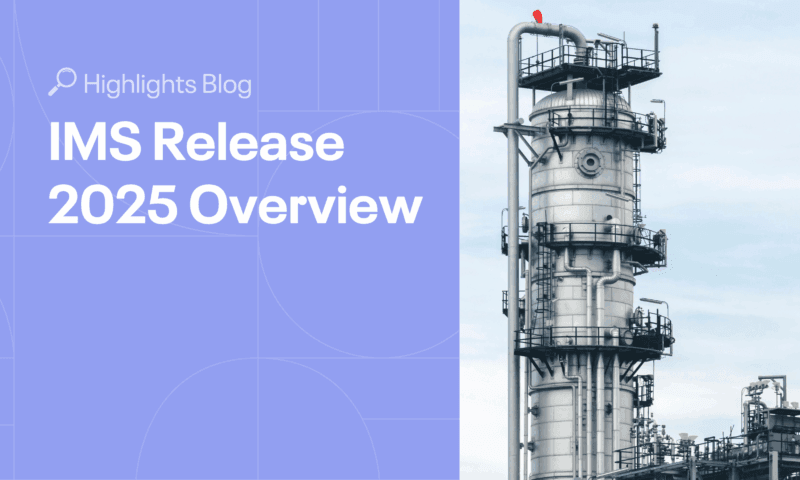Asset Performance Management (APM) refers to a set of strategies, technologies, and methodologies directed at maximizing the efficiency and effectiveness of assets throughout their lifecycle. It involves:
- Methodology: Structured processes and best practices for managing assets, including predictive maintenance, performance monitoring, and continuous improvement.
- Technology: Advanced tools and software for data collection, analytics, and real-time monitoring, enabling predictive and prescriptive insights.
- Strategy: Organizational policies and objectives focused on maximizing asset value, minimizing downtime, and reducing maintenance costs.
Asset Performance Management (APM) includes monitoring asset health, predicting possible failures and optimizing maintenance schedules to minimize downtime and maximize productivity.
Why is Asset Performance Management (APM) important?
The importance of Asset Performance Management (APM) extends across many industries such as Oil and Gas, Chemicals, Pulp and Paper and more. The Oil and Gas Industry particularly emphasizes its implications, where asset reliability directly impacts operational efficiency and profitability.
These solutions provide companies with indispensable insights into the health of their assets – allowing proactive maintenance interventions. By proactively addressing issues and optimizing maintenance schedules, companies can minimize expensive and unplanned downtime and avoid related risks, ensuring smooth operations and maximal productivity.
Additionally, Asset Performance Management (APM) enables organizations to make data-driven decisions improving overall asset performance fostering long-term success.
Benefits of Asset Performance Management (APM)
Asset Performance Management (APM) has numerous benefits that extend well beyond basic maintenance. APM improves operational efficiency and costs by leveraging sophisticated technology and data-driven insights. Here’s how APM helps organizations:
- Cost savings: Anticipates and prevents possible issues, resulting in fewer costly emergency repairs and unplanned downtime.
- Optimized Maintenance: Increases the efficiency of maintenance operations by streamlining schedules and eliminating unnecessary tasks.
- Extended Asset Lifespan: Prolongs asset life by proactive management and timely interventions.
- Improved Asset Utilization: Ensures that assets are used to their greatest capacity, increasing production and efficiency.
- Data-Driven Decision Making: Real-time monitoring and predictive insights enable better informed and strategic decisions.
- Enhanced Operational Efficiency: Lowers downtime and increases productivity, resulting in smoother and more efficient operations.
- Sustainability Support: Contributes to sustainability by lowering energy usage and waste, in line with eco-friendly programs.
Essential steps for optimal Asset Performance Management
Creating an Asset Performance Management (APM) program involves several key steps. Start by setting clear goals and defining the scope of your program. Evaluate your current processes and choose the right tools for data management. Implement analytics to foresee and address issues, and refine your maintenance strategies while regularly measuring performance to ensure ongoing improvement.
1. Define objectives and scope
Begin by determining the objectives you want to achieve with Asset Performance Management (APM), such as lowering downtime or optimizing maintenance costs. Determine the scope of your program by identifying the assets or asset types that will be included, as well as the important metrics that will be monitored.
2. Evaluate the current state and choose tools
Evaluate your present maintenance processes and systems to find gaps and opportunities for improvement. Choose appropriate Asset Performance Management (APM) software that interfaces well with existing systems and facilitates data collecting from a variety of sources, including sensors and historical records.
3. Implement data management and analytics
Collect relevant data from selected sources and ensure its accuracy and consistency. Create predictive models and real-time monitoring systems to anticipate future difficulties and detect them as they occur.
4. Develop maintenance strategies and measure performance
Implement preventative and condition-based maintenance methods based on the outcomes of your data analysis. Define key performance indicators (KPIs) to evaluate the success of your Asset Performance Management (APM) program, and review these metrics on a regular basis to verify they are fulfilling your objectives. Create a feedback loop to continuously improve procedures and change them in response to new insights and technology improvements.
How is APM different from AIM?
While Asset Performance Management (APM) primarily focuses on performance optimization, it’s important to differentiate it from Asset Integrity Management (AIM), which prioritizes ensuring assets operate safely and reliably.
Therefore Asset Performance Management (APM) offers valuable functionalities for optimizing asset performance; it’s essential to recognize that ensuring asset integrity is the core of operational excellence. Asset Integrity Management (AIM) ensures that.
Asset Integrity Management (AIM) goes beyond basic performance optimization; it prioritizes the safety, reliability, and regulatory compliance of assets throughout their lifecycle.
Best of both worlds
Cenosco’s IMS Suite is a group of integrated software solutions designed to support various equipment types and operations within asset-intensive industries. This suite offers a wide range of features that improve asset integrity management, reliability, and safety instrumentation. In recent Verdantix’s Green Quadrant assessment, Cenosco was recognized as an emerging APM for robust asset integrity solutions. In the report, Verdantix advises that CTOs and COOs should consider shortlisting Cenosco for robust asset integrity solutions. This comes down to their IMS Suite’s ability to support users in making smart inspections and maintenance decisions to increase safety, maximize asset availability, and optimize asset management costs
IMS offers a unique perspective on asset integrity as well as comprehensive solutions adapted to the requirements of the Oil and Gas Industry. Similar industries, such as Chemical Manufacturing and Renewable Energy, also use these practices, making IMS an excellent choice for businesses operating in asset-heavy industries.
By integrating Asset Performance Management (APM) functionalities within an Asset Integrity Management (AIM) framework, IMS empowers organizations to achieve operational excellence, minimize risks, and maximize the lifetime of their critical assets.
So, if you’re seeking a solution that prioritizes asset integrity without compromising on performance optimization, IMS is the answer. Verdantix’s Exclusive Report has recognized Cenosco for incorporating extensive asset integrity knowledge into IMS Suite, highlighting its position as a leading solution for the energy and petrochemical industries. Moreover, providing a detailed overview of assets and a thorough understanding of failure mechanisms and maintenance techniques, making it a perfect choice for organizations seeking to enhance safety, reliability, and operational efficiency.
Want to learn more about IMS?
Request a demo below to get a first-hand look at its capabilities!




